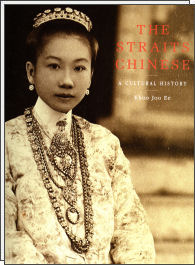EDIZIONE INGLESE 
|
Since ancient times, Southeast Asia has been an important link in the trade routes connecting China with India, Arabia and Europe. Contacts between China and the states of the Malay-Indonesian archipelago were reported as early as the fifth century AD, and Chinese tradespeople began to settle in this region in the 15th century. Chinese communities emerged in the port cities of Java, Sumatra and other islands of the archipelago, and especially along the west coast of the Malay Peninsula, in what would become known as the Straits Settlements: Penang, Malacca and Singapore.
These `Straits Chinese' adapted to a wide variety of local conditions, and — subjected to Malay, European and Indian cultural influences — eventually developed a unique cultural identity. The main characteristics of Straits Chinese arts and architecture are their highly ornate nature, intricate detail and especially their idiosyncratic style, which reflects the above mentioned blend of influences.
This book provides a detailed account of the development of the Straits Chinese social and material culture. The text is illustrated with many historical photographs, and a very large selection of high quality colour plates of architecture, forniture, costumes, beadwork, textiles, embroidery, gold and silver jewellery, domestic objects and ceramics.
Dr Khoo p° Ee, a Straits Chinese from Penang, is the curator of the Asian Art Museum in Kuala Lumpur, Malaysia. She studied fine art and history of art in Malaysia, the Netherlands, England and the USA, and obtained her Doctorate from the University of London in 1976. She has focused more than twenty years of scholarly research on the cultures of Southeast Asia, particularly the Straits Chinese, culminating in this first comprehensive publication on this subject. |
CONTENTS
Acknowledgements
Map of India, China and Southeast Asia Map of Malaysia and Indonesia
Introduction
Sailing ships and luxury goods
1 The Straits Chinese
The Babas and early economic activities Traditional associations
Secret societies
The Sinkhek and tin
Occupational niches
Enclaves
Interracial and intraracial relations
The China connection
Political involvement
The Penang secession movement
2 Religion, Customs and Festivals
Chinese `religion' and customs
Ancestor worship
Religious syncretism
Popular Buddhism
Hungry ghosts
Christianity
Common origins
The Dragon Boat Race
The betel
Rites of passage
Full moon and childhood
The traditional Baba wedding
Childbirth and confinement
Birthdays
Funerals
Festivals
Chinese New Year
Thanksgiving
Chingay
Chap goh meh
The Lantern or Moon Festival
3 Everyday Life
Language
Baba Malay
Penang Hokkien
Education
Chinese schools
English schools
Men's social lives
Associations and clubs
Other pastimes
Women's social lives
Servants and slaves
The Hailam cook-boy
Mui chai
Amah che
Nyonya cuisine
4 Architecture
Secular structures
The shophouse
Terraced houses
Semi-detached houses
The bungalow
Villas
The courtyard mansion
The Chinese garden
Temples
The shophouse tempie
The clan temples of Penang
Theatrical stages
Commemorative structures
Geomancy
Building materials
The house on stilts
5 The Arts
Arts and crafts
Embroidery and beadwork
Techniques and styles of embroidery
Embroidery on footwear
Beadwork
Costumes and accessories
Cosmetics
Chinese styles of clothing
Malay styles
Western attire
The chignon
Nyonya jewellery
Silver and other metalware
Ceramics and glass
Literature
Peranakan publications
The pantun
Performing arts
The pantun and Dongdang Sayang
Boria
Bangsawan
Epilogue: the Straits Chinese Today
Bibliography
Glossary
Index |


Khoo Joo Ee
THE STRAITS CHINESE
editore PEPIN
edizione 1998
pagine 288
formato 24x30
hardcover + jacket
tempo medio evasione ordine
ESAURITO
35.00 €
35.00 €
ISBN : 90-5496-008-6
EAN : 9789054960089
|
|